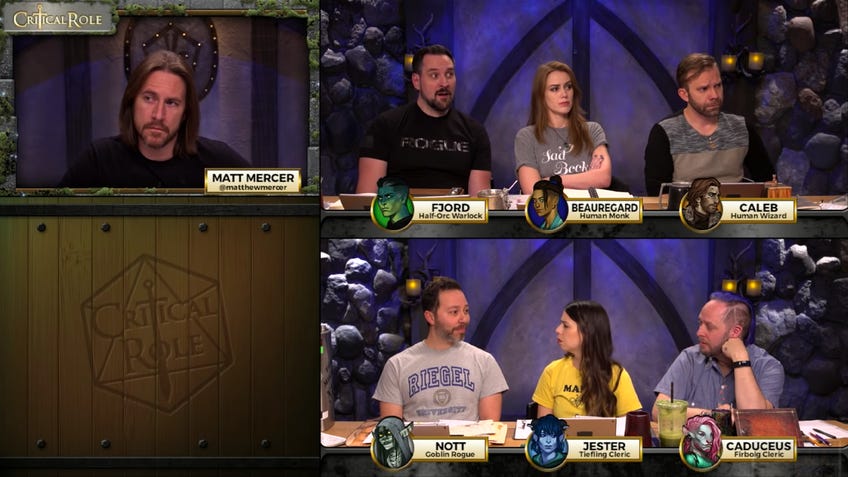As Critical Role has grown, my love for the show has died
This actual play is not actually for me.
Earlier this year, I wrote about how my love for Dungeons & Dragons 5E actual play series Critical Role had grown substantially since the start of Campaign 2. The characters from the Mighty Nein were outcasts and outsiders who had discovered a found family amongst themselves - one that loved them for who they were. Watching those characters transform from lonely weirdos to loved ones was a heartwarming experience - one that gave me a new appreciation for not just Critical Role itself but actual play series in general.
However, since the ending of the second campaign, my love for the series has dimmed substantially. Critical Role has been very popular for a good while now, and whilst my teenage self undoubtedly had a problem with liking something popular, I’ve since gotten over that particular mentality. No, the issue is not necessarily that Critical Role has crossed over to the mainstream - or at least become well-known enough for the cast to appear on the front cover of Variety - but that it feels like the show has lost the last of what made it relatable.
When it was revealed that the third campaign of Critical Role would be taking place in Marquet, a region of Exandria - the world in which Campaigns 1 and 2 took place - that contains deserts and oases, some members of the Critical Role community and beyond were concerned about how such a location would be depicted. As stated in a blog post on the Critical Role website, despite being a fantasy land Marquet “holds nuggets of inspiration from Earth cultures and locations”, with writer and dungeon master Matthew Mercer not confirming what these inspirations and locations were.
Supporting an actual play featuring cast members and writers from those cultures would have been better.
As a cast made up entirely of Caucasian people, many were worried that Critical Role would attempt to wade into cultures that they had no personal connections to or representatives of. Regardless of Mercer’s assurances that he and his team would be working with “professional cultural & sensitivity consultants” throughout the campaign, and that he would attempt to present certain aspects of languages and cultures “without appropriating them”, many were still concerned that it would still come across as a group of people engaging with cultural touchstones that they aren’t a part of. As one Twitter user put it: “Cultural consultants are incredibly important, but they are not a shield [...] given CR’s influence, Marquet is going to be THE setting people look to evoke SWANA [SouthWest Asian/North African] cultures for the foreseeable future.”

I cannot speak for SWANA communities and individuals, but I was certainly a little baffled as to why Mercer and co. had decided to go down this route. Fantasy settings and elements are often at their best when they don’t take direct inspiration from real-world cultures, especially if the people involved aren’t from those cultures. I’m sure the intentions behind the setting choice were good, but I still think it wasn’t the right move for Critical Role to make when there were plenty of other options out there. If the team wanted to represent minority cultures, then supporting an actual play featuring cast members and writers from those cultures would have been a better idea.
I’m excited for those people discovering this world through the show, but I feel like Critical Role has finally passed me by.
Besides the choice of setting for Campaign 3, the reveal that Critical Role was the highest-earning channel on Twitch between August 2019 and October 2021 gave a small insight into how much money the company had been making. Don’t get me wrong, I’m happy for Critical Role’s success. However, a huge part of what made me want to tune in was the fact that the show didn’t feel like the big bells-and-whistles production it is now; it was something that I could connect to as one roleplayer to another. With the Critical Role company establishing its own content policy - which, after an initial backlash from fans, doesn’t seem to be targeting smaller creators - and merchandising just about everything, from Rubik’s Cubes to puzzles, it’s lost that warmth it once had.
I don’t know whether I’m going to watch Campaign 3 of Critical Role. It feels like I’m no longer the target audience of the show. It’s great that Critical Role is hopefully getting more people than ever into tabletop roleplaying games and I’m excited for those people discovering this world through the show. But I feel like Critical Role has finally passed me by.










